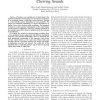Free Online Productivity Tools
i2Speak
i2Symbol
i2OCR
iTex2Img
iWeb2Print
iWeb2Shot
i2Type
iPdf2Split
iPdf2Merge
i2Bopomofo
i2Arabic
i2Style
i2Image
i2PDF
iLatex2Rtf
Sci2ools
BIBM
2007
IEEE
2007
IEEE
Automatic Identification of Temporal Sequences in Chewing Sounds
Chewing is an essential part of food intake. The analysis and detection of food patterns is an important component of an automatic dietary monitoring system. However chewing is a time-variable process depending on food properties. We present an automated methodology to extract sub-sequences of similar chews from chewing sound recordings. The approach is based on a chew-accurate segmentation of the sound signal, a multi-objective evolutionary search for temporal partitions in the sequence using NSGA-II and a validation of the best solution by classification. We evaluate the method on chewing sound recordings from a four participant study, eating foods with different rheological properties. The proposed methodology allows to determine the most appropriate partitioning of the sequences and extract relevant sound features at the same time. Potato chips and chocolate showed a two-phase structure, for lasagne and apples a single-phase structure was derived. The results led to the hypothesis ...
| Added | 12 Aug 2010 |
| Updated | 12 Aug 2010 |
| Type | Conference |
| Year | 2007 |
| Where | BIBM |
| Authors | Oliver Amft, Martin Kusserow, Gerhard Tröster |
Comments (0)

